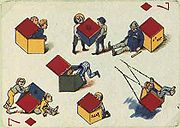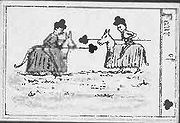
Transformation playing card
Encyclopedia

Playing card
A playing card is a piece of specially prepared heavy paper, thin cardboard, plastic-coated paper, cotton-paper blend, or thin plastic, marked with distinguishing motifs and used as one of a set for playing card games...
where an artist incorporates the pips
Pips
Pips are small but easily countable items. The term is used to describe the dots on dominoes, dice, denote suits, and is the name for the small seeds of some fruits. It could be used as a synonym for dot in most situations, for example morse code....
of the non-face cards into an artistic design. In a classical transformation playing card, the pips retain their standard position and coloration on the card. In some variations, the pips may be different in size, location or color. There is some debate as to whether these cards, often referred to as semi-transformed, should be considered true transformation playing cards.
History

The first transformation playing cards were created by D.W. Soltan and D. Berger in 1801 as illustrations for a German edition of Hudibras
Hudibras
Hudibras is an English mock heroic narrative poem from the 17th century written by Samuel Butler.-Purpose:The work is a satirical polemic upon Roundheads, Puritans, Presbyterians and many of the other factions involved in the English Civil War...
. The cards illustrated were the 2 of hearts, 3 of hearts, 5 of hearts and 8 of hearts. In 1803, John Nixon published the first complete set (52 cards) of transformed cards. Titled Metastasis, this collection was also published as illustrations on sheets of paper. In 1804, J.C. Cotta, a publisher and bookseller in Tübingen
Tübingen
Tübingen is a traditional university town in central Baden-Württemberg, Germany. It is situated south of the state capital, Stuttgart, on a ridge between the Neckar and Ammer rivers.-Geography:...
, Germany, produced the first set of transformation cards that was published as an actual deck of playing cards. These decks were published as almanacs, in which each of the 52 cards corresponded to one of the 52 weeks of the year.
Transformed cards became particularly popular in Victorian England. Their influence can be seen in John Tenniel
John Tenniel
Sir John Tenniel was a British illustrator, graphic humorist and political cartoonist whose work was prominent during the second half of England’s 19th century. Tenniel is considered important to the study of that period’s social, literary, and art histories...
's illustrations for Through the Looking-Glass
Through the Looking-Glass
Through the Looking-Glass, and What Alice Found There is a work of literature by Lewis Carroll . It is the sequel to Alice's Adventures in Wonderland...
. Noted novelist and gambler William Makepeace Thackeray
William Makepeace Thackeray
William Makepeace Thackeray was an English novelist of the 19th century. He was famous for his satirical works, particularly Vanity Fair, a panoramic portrait of English society.-Biography:...
designed 21 cards himself.

An article entitled "Playing Card Squiggles." was published in the December 1910 issue of Strand Magazine
Strand Magazine
The Strand Magazine was a monthly magazine composed of fictional stories and factual articles founded by George Newnes. It was first published in the United Kingdom from January 1891 to March 1950 running to 711 issues, though the first issue was on sale well before Christmas 1890.Its immediate...
. Several Cotta cards were pictured, erroneously attributed to an unnamed French artist. Strand subsequently asked its readers to submit their own designs for card squiggles, which the magazine periodically published. John Butler Yeats
John Butler Yeats
John Butler Yeats was an Irish artist and the father of William Butler Yeats, Lily Yeats, Lollie Yeats and Jack B. Yeats. He is probably best known for his portrait of the young William Butler Yeats which is one of a number of his portraits of Irishmen and women in the Yeats museum in the National...
was one of the first to contribute a card design to the magazine. The feature remained popular for some time.

Contemporary designs
Though not as popular as they were in the 19th century, transformation playing cards continue to be produced. Some, like Art for the Earth by The Friends of the EarthFriends of the Earth
Friends of the Earth International is an international network of environmental organizations in 76 countries.FOEI is assisted by a small secretariat which provides support for the network and its agreed major campaigns...
and Under the Sea by the Marine Stewardship Counsel, are created for charity purposes, with different artists contributing art for each card.
One of the more notable contemporary sets is the award winning The Key to the Kingdom, a semi-transformation deck commissioned by London's V&A Museum of Childhood
V&A Museum of Childhood
The V&A Museum of Childhood in Bethnal Green in the East End of London is a branch of the Victoria and Albert Museum , which is the United Kingdom's national museum of applied arts.-History:...
and created by Tony Meeuwissen. It won the WH Smith Literary Award
WH Smith Literary Award
The WH Smith Literary Award was an award founded in 1959 by British high street retailer W H Smith. Its founding aim was stated to be to "encourage and bring international esteem to authors of the British Commonwealth"; originally open to all residents of the UK, the Commonwealth and the Republic...
for best illustration and The Designers and Art Directory Association of London gold award. This set of cards was created around the theme of nursery rhyme
Nursery rhyme
The term nursery rhyme is used for "traditional" poems for young children in Britain and many other countries, but usage only dates from the 19th century and in North America the older ‘Mother Goose Rhymes’ is still often used.-Lullabies:...
s and poems. The cards were sold with a book containing each poem and a picture of the corresponding card on the opposite page. Additionally, the deck was constructed as a puzzle contest
Puzzle contest
Puzzle contests are popular competitions in which the objective is to solve a puzzle within a given time limit, and to obtain the best possible score among all players.-History:One of the earliest puzzle contests was held about 1910...
laid out in the form of an original poem. The poem gave clues to pick certain cards, which then could be decrypted into a secret message.
The prize of $10,000 and a golden key was won by Susan Kavanagh of Essex.
External links
- The International Playing Card Society - Gallery of various transformations of the four of diamonds.
- Folio Boutique - Tony Meeuwissen - Gallery of cards from Tony Meeuwissen's transformation deck, The Key of the Kingdom.

